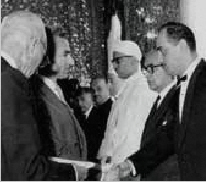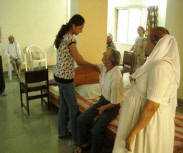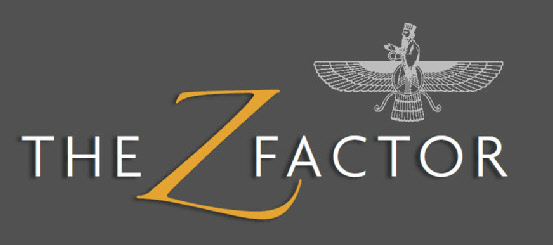
Zoroaster and his teachings
Legend has it that when Zoroaster was born, he laughed. His date and place of birth are uncertain, but it is thought he was born in Central Asia around the Aral Sea and lived in the Iranian Bronze Age 1800–1100BC, receiving his revelation at the age of 30. His first disciple was his cousin, and then royalty, King Vishtaspa of Bactaria, and his Queen, Hutoxshi, whose lame horse he miraculously cured.
Zoroaster was the first prophet to preach a monotheistic religion, based on a loving God. His sacred texts were written in the ancient Avestan language.
Zoroaster’s view of the world was according to the law of Asha, signifying truth, order, eternal justice and the righteous way. He advocated the protection of all creation. He was the first religious leader to teach that there was a
Heaven and Hell, angels and demons, the Coming of a Messiah, a Day of Judgement, the Resurrection and Life Everlasting.
Zoroaster was a ‘New Man’. He stressed equal rights and responsibilities for women
and men. They had to use their conscience to decide whether they would be co-
Zoroaster was the genius who stressed that life should be cherished, and that there was no escape from being judged for our thoughts, words and deeds. His revolutionary ideas have had the most extraordinary impact on the world’s faiths and on modern civilisation.
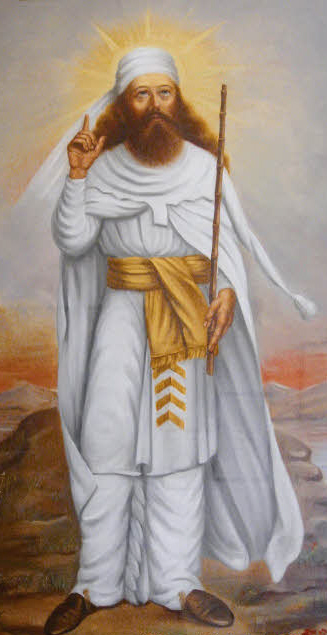
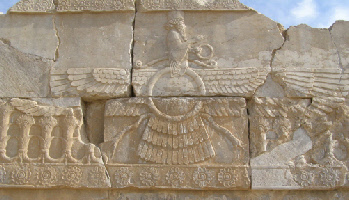
The Faravahar carved in the rocks in Iran.
Faravahar
The Faravahar is the symbol of Zoroastrianism, thought to represent a guardian angel. For thousands of years Zoroastrianism was the main religion of the Persian Empire during the Achaemenid Empire (558–330 BC), the Parthian Empire (AD 247–224) and the Sassanid Empire (AD 224–651), until the Arab invasion in 541 BC when the region was converted to Islam.
Today Zoroastrians are known as Zarthoshti or Vehdin, the followers of the good religion. The term Parsi describes Zoroastrians who migrated to India in the 10th century AD and simply means people from Persia. Zoroastrians who emigrated
from Iran in the late 19th and early 20th centuries to seek religious freedom which was guaranteed in British India were known as Iranis.
Representation of the prophet, Zoroaster.
Places of worship
Zoroastrians worship in Fire Temples. They do not worship fire as their religion
rejects worship of any idols. The Sacred Fire is revered as a visible symbol of the
inner light, the divine spark that burns in every heart and the ultimate purifier.
All rituals and prayers are performed in the presence of a fire, tended with sandalwood
and frankincense in a silver urn. Non-
Zoroastrian Sacred Fire.
Cyrus the Great
Cyrus (558BC–530BC), founder of the Achaemenid Persian Empire, was the first ruler to be called Great.
Today he is known as the Father of Human Rights. He was immortalised in the Bible by the Jewish prophets, Ezra and Isaiah, the only Gentile to be glorified as King of Kings and the Anointed of the Lord. Cyrus’s greatness lay in uniting the Medes and the Persian tribes, creating
the largest empire the ancient world
had seen, and liberating the enslaved
peoples. He helped the Jewish captives in Babylon return to Jerusalem and rebuild their temple.
He Respected the customs and religions of all the lands of the ancient world that he conquered – the first Interfaith champion.
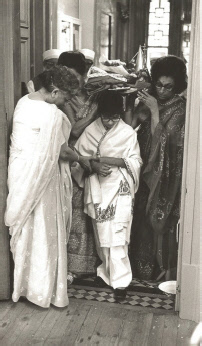
The Navjote ceremony of Zerbanoo’s brother, Naswan.
Navjote
The Zoroastrian Navjote is the Initiation Ceremony, like the Jewish Bar Mitzvah. Boys and girls are confirmed in the faith with the recital of the sacred prayers. They are presented with a Sudra, a white muslin vest with a symbolic pocket in the front to remind the wearer to fill it up every day with good deeds. The young Zoroastrian is also given the Kusti, a fine wool cord made up of 72 strands symbolising the 72 chapters of Yasna, the Book of Worship. The Kusti is tied
around the waist during morning and evening prayers, with three reef knots as a reminder to fight evil and to follow the teachings of Zoroaster.
World Zoroastrian
Organisation
The World Zoroastrian Organisation is the global body for Zoroastrians. It brings together a community that is now dispersed all over the world.
It was set up to give Zoroastrians a unified voice on the international stage. Their work centres around charity; whether it is poverty alleviation, disaster relief,
medical aid, housing, or educational scholarships, it is done with a belief that it is a Zoroastrian’s duty to act with compassion and generosity.
Bailey Irani, Founder-
A young Zoroastrian caring for the old and infirm.


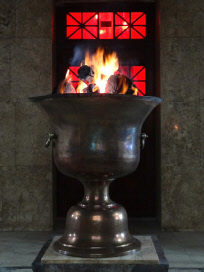
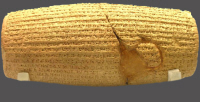
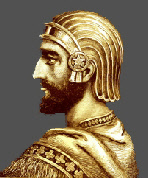
Cyrus the Great’s Cylinder of Rights, now in the British Museum.
